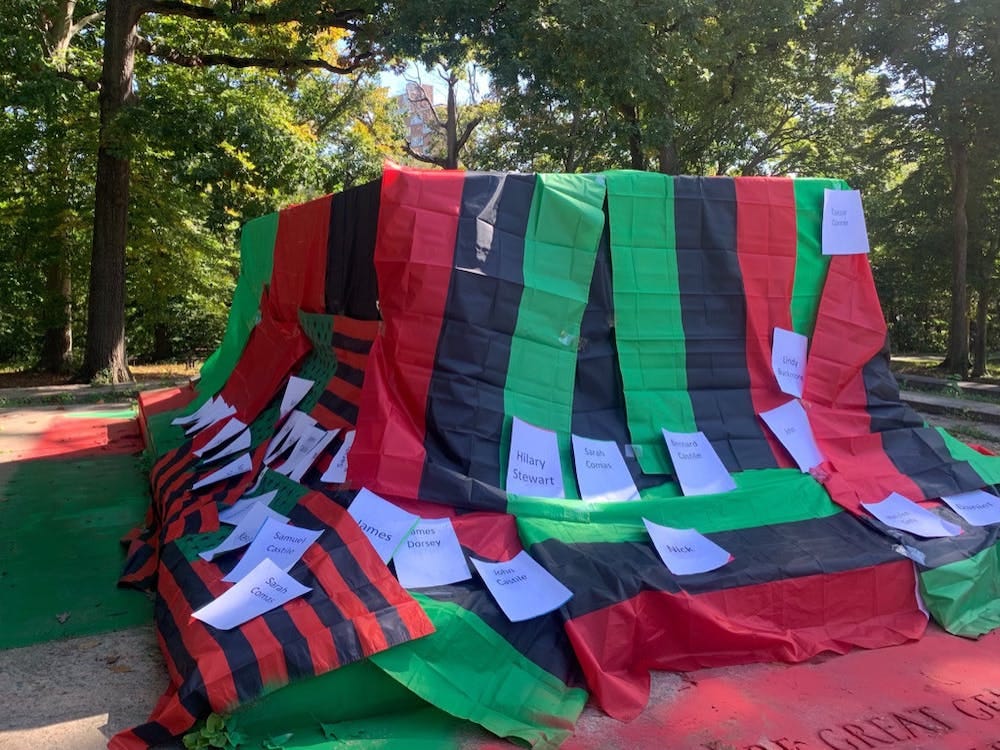they ask me to remember
but they want me to remember
their memories
and I keep on remembering
mine
— Lucille Clifton, “why some people be made at me sometimes”
This fall, we’re eager to discover the many places where Baltimore’s hard history is being written and rewritten, where our past is being remembered. Already, we’re following programs sponsored by JHU’s Right to the City Seminar (you can tune into their recent discussion of “The City and Black Nationalism” here.) Inheritance Baltimore and the Program in Racism, Immigration, and Citizenship recently sponsored a Walk of Remembrance, that ended at the Harriet Tubman Memorial Grove in the Wyman Park Dell (pictured below).
This fall, we’re getting out to discover what else is new. You can find us exploring Baltimore’s past and how we tell it. Always, we’re asking questions about what is easy and what is hard, what is myth and what is fact, what moves us forward and what hold us back. We hope to cross paths with you!
Memory in Middle East Baltimore. On Sunday October 23rd, the Middle East Baltimore Memory Project will formally unveil a new mural, described as a “a public archive project … to create an equitably accessible history of Middle East Baltimore. This public catalogue will contain over 150 archival images of the neighborhood's various community organizations, present day photos of the neighborhood and under highlighted leaders.” Space is limited, so please register here. At Hard Histories, we’ll compare this memory project to that inaugurated in April 2022 at The McDonogh School, “The Memorial to Those Enslaved and Free.”
Slavery, Racism, and Transportation. Baltimore’s B&O Railroad Museum opened a new, permanent exhibition on its connection to enslavement: “The Underground Railroad: Freedom Seekers.” The museum explains how this new installation “gives an intimate look at the lives and journeys of 27 individuals who sought freedom from slavery along the B&O.” We’ll be asking how this story connects to the post-slavery rise of segregated rail travel in Baltimore, explored here by Hard Histories lab member Ariella Shua.
Great Migrations. Starting October 30, the Baltimore Museum of Art will host “A Movement in Every Direction: Legacies of the Great Migration.” It tells this story through a contemporary lens with “newly commissioned works across media by 12 acclaimed Black artists.” Some of you will recall Baltimore Magazine’s deep-dive into the same subject in 2020: “The Great Migration: How Black Families Came “Up South,” Faced Down Jim Crow, and Built a Groundbreaking Civil Rights Movement.” In his 2006 article “Ruralizing the City: The Great Migration and Environmental Rehabilitation in Baltimore, Maryland,” anthropologist Austin Zeiderman suggests how the migration to Baltimore is still visible on the cityscape. At Hard Histories, these confrontations between history and memory are rich sites for understanding how the past powerfully informs and still shapes our present.
Our Civil Rights Archive. The Maryland Center for History and Culture opened “Passion and Purpose: Voices of Maryland’s Civil Rights Activists,” in May to tell how “Marylanders were and are at the forefront of the Black freedom struggle.” We’re eager to see the exhibit to better understand the era in which Johns Hopkins University came to rethink the place of Black students on its campuses. Also exciting is how MCHC has opened its McKeldin-Jackson Project oral history collection and the Doris M. Jackson Project oral history collection to the public. This work is a reminder for us of how, even as our research recovers the past, the historical archive is being made and remade.
Poet Lucille Clifton spent important years in Baltimore as a prolific writer, beloved teacher, and Maryland’s Poet Laureate from 1979 to 1985. Her short poem, “why some people be made at me sometimes,” expresses with elegant resolve how contested our memories are. She calls on us to always ask by whom is this memorial being produced and then for whom. In Baltimore, we can discover answers to these questions — and the processes that produced them — on building walls, in exhibit galleries, trekking the cityscape, and in the words of elders preserved in transcripts and on audio tapes. Your memories may not be mine. And still Clifton’s thinking challenges us to discover those memories we all need to make a new future.
— MSJ




